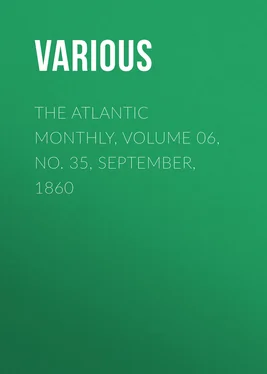Various - The Atlantic Monthly, Volume 06, No. 35, September, 1860
Здесь есть возможность читать онлайн «Various - The Atlantic Monthly, Volume 06, No. 35, September, 1860» — ознакомительный отрывок электронной книги совершенно бесплатно, а после прочтения отрывка купить полную версию. В некоторых случаях можно слушать аудио, скачать через торрент в формате fb2 и присутствует краткое содержание. Жанр: foreign_antique, periodic, foreign_edu, на английском языке. Описание произведения, (предисловие) а так же отзывы посетителей доступны на портале библиотеки ЛибКат.
- Название:The Atlantic Monthly, Volume 06, No. 35, September, 1860
- Автор:
- Жанр:
- Год:неизвестен
- ISBN:нет данных
- Рейтинг книги:5 / 5. Голосов: 1
-
Избранное:Добавить в избранное
- Отзывы:
-
Ваша оценка:
- 100
- 1
- 2
- 3
- 4
- 5
The Atlantic Monthly, Volume 06, No. 35, September, 1860: краткое содержание, описание и аннотация
Предлагаем к чтению аннотацию, описание, краткое содержание или предисловие (зависит от того, что написал сам автор книги «The Atlantic Monthly, Volume 06, No. 35, September, 1860»). Если вы не нашли необходимую информацию о книге — напишите в комментариях, мы постараемся отыскать её.
The Atlantic Monthly, Volume 06, No. 35, September, 1860 — читать онлайн ознакомительный отрывок
Ниже представлен текст книги, разбитый по страницам. Система сохранения места последней прочитанной страницы, позволяет с удобством читать онлайн бесплатно книгу «The Atlantic Monthly, Volume 06, No. 35, September, 1860», без необходимости каждый раз заново искать на чём Вы остановились. Поставьте закладку, и сможете в любой момент перейти на страницу, на которой закончили чтение.
Интервал:
Закладка:
Such are its picturesque aspects: but in a figurative light it may be regarded as a true symbol of benevolence. Under its outspread roof, thousands of otherwise unprotected animals, nestling in the bed of dry leaves which it has spread upon the ground, find shelter and repose. The squirrel subsists upon the kernels obtained from its cones; the rabbit browses upon the Trefoil and the spicy foliage of the Hypericum which are protected in its conservatory of shade; and the fawn reposes on its brown couch of leaves, unmolested by the outer tempest. From its green arbors the quails may be roused in midwinter, when they resort thither to find the still sound berries of the Mitchella and the Wintergreen. Nature, indeed, seems to have designed this tree to protect the animal creation, both in summer and winter, and I am persuaded that she has not conferred upon them a more beneficent gift.
As an object of sight, the White Pine is free from some of the defects of the Fir and Spruce, having none of their stiffness of foliage and inflexibility of spray, that cause them to resemble artificial objects. It has the symmetry of the Fir, joined with a certain flowing grace that assimilates it to the deciduous trees. With sufficient amplitude to conceal a look of primness that often arises from symmetry, we observe a certain negligent flowing of its leafy robes that adds to its dignity a grace which is apparent to all. It seems to wear its honors like one who feels no constraint under their burden; and when smitten by a tempest, it bids no defiance to the gale, bending to its wrath, but securely resisting its power.
Of the American coniferous trees, the Hemlock is of the next importance, being, perhaps, in its perfection, a more beautiful tree than the White Pine, or than any other known evergreen. It is far less formal in its shape than other trees of the same family. Its branches, being slender and flexible, do not project stiffly from the shaft; they bend slightly at their terminations, and are easily moved by the wind; and as they are very numerous, and covered with foliage, we behold in the tree a dense mass of glittering verdure, not to be seen in any other tree of the forest.
The Hemlock is unknown as a shade-tree; it is seldom seen by the road-side, except on the edge of a wood, and not often in cultivated grounds. The want of success usually attending the transplantation of it from the woods has prevented the general adoption of it as an ornamental tree. The Hemlock, when transplanted from the wood, is almost sure to perish; for Nature will not allow it to be desecrated by any association with Art. She reserves it for her own demesnes; and if you would possess one, you must go to its native spot and plant your garden around it, and take heed, lest, by disturbing its roots, you offend the deity who protects it. Some noble Hemlocks are occasionally seen in rude situations, where the cultivator's art has not interrupted their spontaneous growth; and the poet and the naturalist are inspired with a more pleasing admiration of their beauty, because they have seen them only where the solitary birds sing their wild notes, and where the heart is unmolested by the crowding tumult of human settlements.
The Pitch Pine has neither grace nor elegance, and though it is allied botanically to the pyramidal trees, it approaches the shape of the round-headed trees. There is a singular ruggedness about it; and when bristling all over with the stiff foliage that sometimes covers it from the extremities of the branches down almost to the roots, it cannot fail to attract observation. Trees of this species, for the most part too rough and homely to please the eye, are not generally valued as objects in the landscape; but there is a variety in their shape that makes amends for their want of comeliness, and gives them a marked importance. We do not in general sufficiently appreciate the value of homely objects among the scenes of Nature,—which are, indeed, the ground-work of all charming scenery, and set off to advantage the beauty of more comely things. They prepare us, by increasing our susceptibility, to feel more keenly the force of beauty in other objects. They give rest and relief to the eye, after it has experienced the stimulating effects of beautiful forms and colors, which would soon pall upon the sense; and they are interesting to the imagination, by leaving it free to dress the scene with the wreaths of fancy.
It is from these reflections that I have been led to prize many a homely tree as possessing a high value, by exalting the impressions of beauty which we derive from other trees, and by relieving Nature of that monotony which would attend a scene of unexceptional beauty. This monotony is apparent in almost all dressed grounds of considerable extent. We soon become entirely weary of the ever-flowing lines of grace and elegance, and the harmonious blending of forms and colors introduced by art. On the same principle we may explain the difficulty of reading with attention a whole volume on one subject, written in verse. We are soon weary of luxuries; and when we have been strolling in grounds laid out with gaudy flower-beds, the tired eye, when we go out into the fields, rests with serene delight upon rough pastures bounded by stone walls, and hills clothed with lichens and covered with boulders.
The homely Pitch Pine serves this important purpose of relief in the landscapes of Nature. Trees of this species are abundant in sandy levels, in company with the slender and graceful White Birch, "The Lady of the Woods," as the poet Coleridge called it. From these Pines proceed those delightful odors which are wafted to our windows by a mild south wind, not less perceptible in winter than in summer, and which are in a different manner as charming as a beautiful prospect.
The Juniper, or Red Cedar, known in some places as the Savin, is another homely tree that gives character to New England scenery. It is one of the most frequent accompaniments of the bald hills near certain parts of our coast, giving them a peculiar aspect of desolation. This tree acquires larger dimensions and a fuller and fairer shape in the Middle and Southern States. There the Junipers are beautiful trees, having a finer verdure than they ever acquire at the North. But the Juniper, with all its imperfections, its rugged form, and its inferior verdure, is not to be contemned; and it possesses certain qualities and features which ought to be prized hardly less than beauty. Its sombre ferruginous green adds variety to our wood-scenery at all times, and by contrast serves to make the foliage of other trees the more brilliant and conspicuous. In the latter part of summer, when the woods have acquired a general uniformity of verdure, the Junipers enliven the face of Nature by blending their duller tints with the fading hues of the fully ripened foliage. Thus will an assemblage of brown and gray clouds soften and at the same time enliven the deep azure of the heavens.
In this sketch, I have omitted to describe many important trees, especially those which have but little individuality of character, leaving them to be the subject of another essay concerning Trees in Assemblages. I have likewise said nothing here of those species which are commonly distinguished as flowering trees. But I must not omit, while speaking of the pyramidal trees, to say a word concerning the Larch, which has some striking points of form and habit. Like the Southern Cypress, it differs in its deciduous character from other coniferous trees: hence both are distinguished by the brilliancy of their verdure in the early part of summer, when the other evergreens are particularly sombre; but they are leafless in the winter. The Larch is beautifully pyramidal in its shape when young. In the vigor of its years it tends to uniformity, and to variety when it is old. Indeed, an aged Larch is often as rugged and fantastic as an old Oak. The American and European Larches differ only in the longer flowing foliage and the larger cones of the latter. Among the minor beauties of both species may be mentioned the bright crimson cones that appear in June and resemble clusters of fruit. The Larch is a Northern tree, being in its perfection in the latitude of Maine. It seems to delight in the coldest situations, and, like the Southern Cypress, is found chiefly in low swamps.
Читать дальшеИнтервал:
Закладка:
Похожие книги на «The Atlantic Monthly, Volume 06, No. 35, September, 1860»
Представляем Вашему вниманию похожие книги на «The Atlantic Monthly, Volume 06, No. 35, September, 1860» списком для выбора. Мы отобрали схожую по названию и смыслу литературу в надежде предоставить читателям больше вариантов отыскать новые, интересные, ещё непрочитанные произведения.
Обсуждение, отзывы о книге «The Atlantic Monthly, Volume 06, No. 35, September, 1860» и просто собственные мнения читателей. Оставьте ваши комментарии, напишите, что Вы думаете о произведении, его смысле или главных героях. Укажите что конкретно понравилось, а что нет, и почему Вы так считаете.












